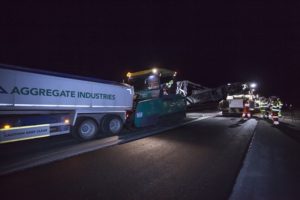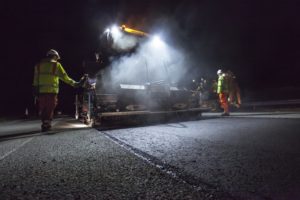
Construction Plant News reports on a trial project that promises to shorten road closures, reduce material costs and improve pavement life.
The construction sector has often been guilty of settling for the conventional in its build practices, and the process of road renewal and repair is a case in point.
That was until Aggregate Industries, Kier and Highways England deviated from the path well-trodden in a collaboration that has brought a new method of asphalt paving to these shores.
Already commonplace in its native Germany, hot-on-hot paving promises to drive significant savings in time and materials, and earlier this year a trial project on the M6 demonstrated its effectiveness.
 “Aggregate Industries believed it was the way forward and, given that Highways England is always in the market for cost savings, it was a pretty easy sell,” explains Steve Parsons, Kier Roads Manager for Area 13.
“Aggregate Industries believed it was the way forward and, given that Highways England is always in the market for cost savings, it was a pretty easy sell,” explains Steve Parsons, Kier Roads Manager for Area 13.
“Initially there was a debate over whether what is also known as inline paving would represent a departure from standards but once that was resolved we were free to proceed.”
The original approved design for the stretch of the M6 between Burton and Cinderbarrow was a 60mm binder and 40mm surface course, but through the inline paving process it is possible to lay both these courses in a single pass, producing what is effectively one homogenous layer.
Using this method it is also possible to adjust the depths of those layers, and the result is a 70mm binder and 30mm surface course, which represents a significant saving of the latter and more expensive material.
It’s not just the constitute amounts of material that’s reduced, however. One of Highways England’s primary goals in renewal works is to ensure that road closures are as brief as possible, and is encouraging its supply chain to adopt innovative methods to make that happen.
Through the Road Investment Strategy the organisation has been charged with undertaking billions of pounds worth of repair and resurfacing work, as well as entirely new schemes, and government is demanding value for money.
Using this method, with two layers laid in one pass significant time savings are generated, with the associated economic benefit of a fully functioning highway in a shorter timeframe, but that’s not the only impact on the end user motorist.
Hot-on-hot paving has been demonstrated in its homeland to provide a much improved running surface, with the continuous movement of material it affords resulting in less joins, and a better ride quality.
So why has this method not been seen on these shores before, especially with Whitehall promising such a significantly increased level of spending on the network? “One of the major stumbling blocks to the adoption of hot- on-hot paving has been an absence of the necessary equipment,” continues Steve.
on-hot paving has been an absence of the necessary equipment,” continues Steve.
“A high compaction screed paver was used which is required, with the Vogele unit employed as the front paver to lay the binder layer on the M6 specifically brought in for this project by Aggregate Industries.
“The binder layer that comes out of the back of this machine is virtually compacted so there’s no need for a roller to run between the two, and the surface course can then be run directly behind it.
“As far as the workforce was concerned there was no drastic deviation from what they would already be accustomed to – only different amounts of material were being laid.
“The difficulty came in feeding the second paver with the surface course, this was achieved by Utilising a Vogelle Material Transfer Vehicle (MTV) which at the moment is the only one of its type in the UK, the material is then compacted using conventional equipment.”
The fact that what is produced is essentially a single layer also has the potential for further savings by extending the life of the highway.
Conventionally, laying a binder course, and then a surface course on top can result in delamination. By contrast, cores taken from inline paving trials in Germany have revealed that the layers are effectively compacted into one 100mm layer, and that the chance of failure is then drastically reduced.
Following the success of inline paving in Area 13 there is another Kier project in the pipeline for Area 9. For further information on some of the contractor’s latest projects visit www.kier.co.uk








